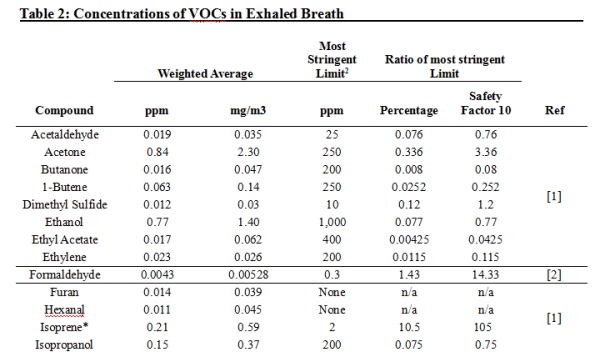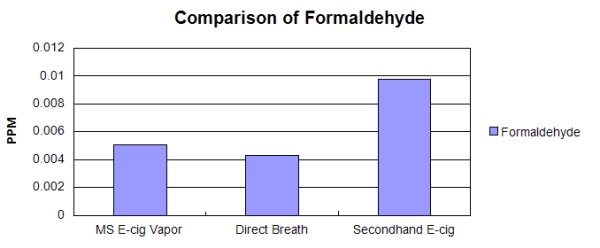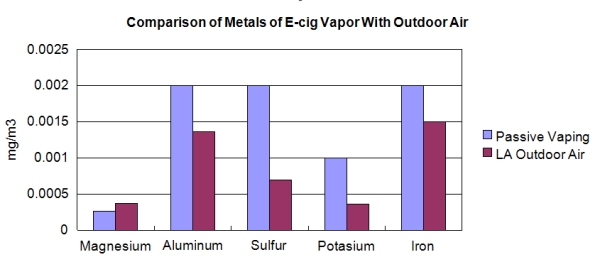
The use of electronic cigarettes in public places has been a hot topic among local government officials. City councils in New York and Chicago have already voted to regulate e-cigarette usage the same way they treat tobacco smoking, meaning vaping will soon be prohibited anywhere smoking isn't allowed in public places. Los Angeles has announced a plan to amend its own smoke-free air law to include e-cigarettes, on the basis their vapor contains toxins and carcinogens. According to a report submitted to the Arts, Parks, Health, Aging, and River Committee by LA city attorney Michael Feuer, recent studies have also found levels of lead, chromium, nickel, and nicotine in the second-hand vapor of e-cigs. Prohibiting electronic cigarette use wherever smoking is banned, Feuer contends, is necessary in order to protect bystanders from involuntary inhalation of the vapor they emit.
Read the full report on e-cig emissions and air contaminants.
While studies on electronic cigarettes have indeed found trace elements and compounds in passive e-cig vapor, none have been detected at levels that warrant any concern to public health. Dr. Igor Burstyn's recent study analyzed over 9,000 observations of electronic cigarette vapor content reported in various peer reviewed and grey literature studies and concluded secondhand vapor exposure poses no concern to bystanders. However, lawmakers seem to exclude these results from their proposals. Furthermore, they seem unaware that a high percentage of the constituents in secondhand e-cig vapor already exist in smoke-free air and can be attributed to natural production by the human body. After conducting some fairly extensive research, I was able to (unscientifically) compare constituents of electronic cigarette vapor with those of human breath emissions and outdoor air at three LA locations. In short, passive vapor may be no more harmful (and probably way better smelling) than vapor-free human breath and even outdoor air.
Summary
- Five of the volatile organic compounds detected by various studies in electronic cigarette vapor have also been found in human breath emissions (acetaldehyde, acetone, butanone, formaldehyde and isoprene).
- Five of the VOCs found in e-cig vapor were also detected in trace amounts of outdoor air at three Los Angeles locations (Acetaldehyde, Benzene, Formaldehyde, m,p-Xyelene, and Toluene).
- Five of the metals that have been detected in e-cig vapor were also found in comparable quantities in LA outdoor air (aluminum, iron, magnesium, potassium and sulfur).
- This shows than much of what has been detected in passive vapor studies can be attributed to natural production by the human body.
- Even though VOCs and metals have been found in e-cig vapor, human breath and outdoor air, all have been detected at levels well within regulatory and recommended exposure limits.
E-Cigarettes Compared With Human Breath
It's fairly common knowledge that the outdoor air in cities like Los Angeles and adjacent communities can be polluted from road traffic and factory emissions, among other sources. But not too many people realize indoor air can be polluted as well, and one of the sources may be surprising. Because the human body naturally produces several volatile organic compounds, a person's breath can be a source of indoor air pollution. But there is no need to go running to your local hardware store to purchase a particle respirator, at least not if you live anywhere in the United States.
A study conducted in 1999 and published online in 2011 measured human breath emissions and detected an array of volatile organic compounds, some carcinogenic while others not. Among VOCs found in human breath, five have also been detected in secondhand e-cigarette vapor. These include acetaldehyde, acetone, butanone, formaldehyde and isoprene. However, aside from formaldehyde, none were detected at any significant levels in comparison to their corresponding exposure limits.
Because the study measured human breath directly using either Teflon bags or a GC/Flame Ionization Detector, it's hard to compare the results with those of passive vaping studies. It is important to note, however, that some of the volatile organic compounds found in e-cig vapor be attributed to natural human breath production. For example, the chart below shows a comparison of mainstream e-cig vapor with passive vapor and human breath.

Formaldehyde has been detected at almost equal levels in both mainstream e-cigarette vapor and human breath. The chart above suggests that human breath is probably a main component of the formaldehyde detected by studies on passive vaping. Interestingly, acetone measured quite on human breath emissions when compared to e-cigarette vapor measured in a smoking machine.

E-Cigarettes Compared With LA Outdoor Air
What was most surprising about this research, outdoor air measured at three Los Angeles locations seems to be cleaner, in terms of VOCs, than human breath. On the contrary, results published in a 2012 South Coast AQMD study showed more than a comparable levels of trace elements, or what the media refers to as metals, in outdoor air with those of e-cigarette vapor.

Again, five of the same elements previously detected by scientists in the vapor of electronic cigarettes were also found in the air of the three measuring sites in the city of Los Angeles. But, as with VOCs in human breath, these results shouldn't alarm anyone. Along with the levels of trace elements contained in e-cigarette vapor, these levels are extremely low and don't even come close to approaching exposure limits.
Conclusion
None of the air we breath is pure, but that doesn't mean it isn't safe to breathe in. This research only shows that many of the constituents of e-cig vapor are also found in both vapor-free indoor and outdoor air. It's nothing to be alarmed at. What it does suggest, however, is that the argument for banning e-cig use on the basis vapor contains dangerous chemicals and metals is now only as good (or bad) as the argument on banning flavors because they appeal to minors.The fact is that alcohol is also sold in flavors and the very air in public places, officials argue they are trying to protect, already contains many of the same elements found in e-cigarette vapor that they are using to pass these ordinances.
Cities need to find other reasons to ban e-cigarette use in public places because everything they've come up with so far just seems like scare tactics, just as these studies on human breath emissions and outdoor air pollution could have been used to scare people into staying home for fear of inhaling the great unknown that exists in the real world.

